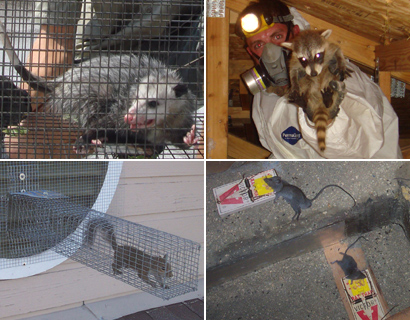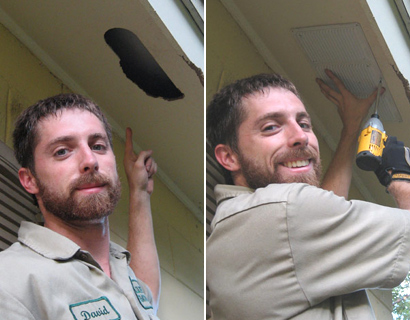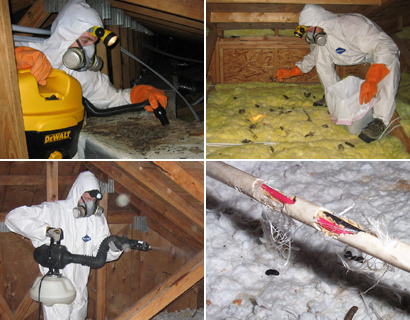- How We Solve Florida Wildlife Problems
How We Solve Charlotte County Wildlife Problems
INSPECTION: Once on site, we will perform a full inspection of your home and property. This allows us to use the correct strategy and traps. If the animals are in an attic, a full building inspection is crucial, including the following:
- All ground-level areas, such as piper or A/C line entry & exit areas, A/C chase bottoms, ground-level vents, etc.
- All mid-level areas, such as dryer vents, siding gaps, first floor eaves or dormers, etc.
- We inspect the entire roof, including all plumbing stacks, ridge caps, vents, and other potential gaps or holes.
- We also inspect inside your attic, to identify animals and damage they have caused.
- If the animals are outside, we notice many subtle clues that will assist us in a successful strategy.
TRAPPING, EXCLUSION, REMOVAL: Once we understand what animal species we are dealing with, and the problem, we use the most effective means of removing the animals. We use dozens of different types of traps.
- Trapping - If trapping the animal(s) in live cage traps, trap type, set, and location are crucial to success.
- Exclusion - Oftentimes, we are able to simply set one-way doors or other exclusion devices that allow the animals inside a building to safely exit, but never get back inside.
- Removal By Hand - Sometimes we actually remove animals by hand, or with special tools like snare poles.
- The Law - In all cases, we obey state and local laws regarding wildlife, but aim to take the most humane approach.
ENTRY HOLE REPAIRS: Repairs are a crucial step in the wildlife removal process. In many cases, such as bat or rodent control, the job cannot be performed without detailed repairs, and in all cases, sealing the entry holes shut ensures that no future wildlife will ever enter your home.
- 100% of the entry holes must be found, and sealed shut, or the job is not complete.
- Our repairs are professional contractor grade, look good, and when applicable we use steel, which rodents such as rats or squirrels are unable to chew through.
- We give a written guarantee on our repairs against any future animal entry.
ATTIC DECONTAMINATION SERVICES: It may be desirable to clean your attic after we've removed the animals. They can leave behind large amounts of droppings, urine, hair, oils, food, nesting material, and so on. These remnants can attract insects like cockroaches, and the scent left behind can encourage new animals to chew their way into your house. You might experience odor problems from the waste. It's possible that mold will grow on waste areas.
- We remove or vacuum all droppings, or remove all the soiled insulation.
- We fog the attic with a special enzyme-based cleaner that destroys any organic matter and deodorizes the space.
- We repair damage, such as ductwork, electrical wires, pipes, insulation, and more.
We are a wildlife control company who is family-run, and our top specialty includes removing a number of wild animals that inhabit your attic. If, like other homeowners, you hear noises coming from your ceiling during the night, there’s a good chance you may have squirrels, raccoons, rats or bats up there. We can help you remove those animals, as well as others that may come across your home. We’re also great for getting rid of groundhogs, skunks and more from under porches and sheds, and we can even deal with the disposal of dead wild animals also. It’s not just the live ones we make time for! When catching animals such as opossums or raccoons, we will make sure that when we relocate them, we do so at least ten miles away so it can’t come back. Even if it did, it wouldn’t be able to get back in, because we would seal all cracks, holes and crevices we come across during our 32-point inspection system of your home. Our attention to detail is what keeps those critters out, and what makes our customers happy also. They’ve rated us the #1 wildlife control company in the metropolitan area for three years in a row! Get in touch today to find out how we can help you and your home or commercial property.
We service Sarasota County, DeSoto County, Highlands County, Glades County, Hendry County, Lee County, and more. We also service Punta Gorda, Babcock Ranch, Charlotte Harbor, Grove City, Rotonda, Charlotte Park, Harbor Heights, Solana, Cleveland, Manasota Key, Englewood, Port Charlotte, Adrian Town, Little Gasparilla Island, Boca Grande, Murdock, Cape Haze, Placida, Deep Creek, South Gulf Cove, and more. To learn more about our services, visit the Charlotte County wildlife control home page.
This month's wildlife how-to article: How do I clean wild animal feces out of my attic?
After locating feces, be sure to practice safe handling techniques for wild animal scat. Also, keep in mind that diseases can be transmitted through urine, which may have dried and appear invisible to the eye. If you choose to endeavor to clean up your attic on your own, wear long sleeves, long pants, protective eyewear, and a facemask while cleaning. Gloves are the most important protection you can manage here. Be sure they are waterproof (i.e. vinyl or latex) so you do not risk transmitting any diseases through moist towels or paper towels. It is also a good idea to make sure the animals have been evacuated from the attic before you begin cleanup, or else the process might be an ongoing and worsening one over time.
Many people will simply sweep up or vacuum rodent scat if it is found in their house assuming the validity of the “out-of-sight, out-of-mind,” idiom, but sweeping or vacuuming will worsen the problem by scattering miniscule, dried bits of scat material into the air, thereby increasing the potential to contract disease via inhalation—i.e. an airborne disease.
Once the animals have been evacuated cleaning should be conducted using bleach and water, and any materials you throw away should be put in a bag that is tied and disposed of in your outside trash receptacle immediately afterwards. When tying the bag, be sure it is aimed away you’re your face or the faces of others to prevent particles of scat from being projected into the air.
Depending on the surface you are cleaning, you can use paper towels, or sponges, but remember that these must be thrown away as well. After spraying bleach and water, let it soak to make sure any bacteria are killed. Five minutes is a good amount of time, but remember not to touch your face or skin while you are waiting. A good way to spend your time, if you feel the need to itch, is to search the surrounding area for any potential routes, pathways, or missed nooks and crannies that might also be contaminated. Always wash your clothes and body thoroughly after handling potentially diseased material.





